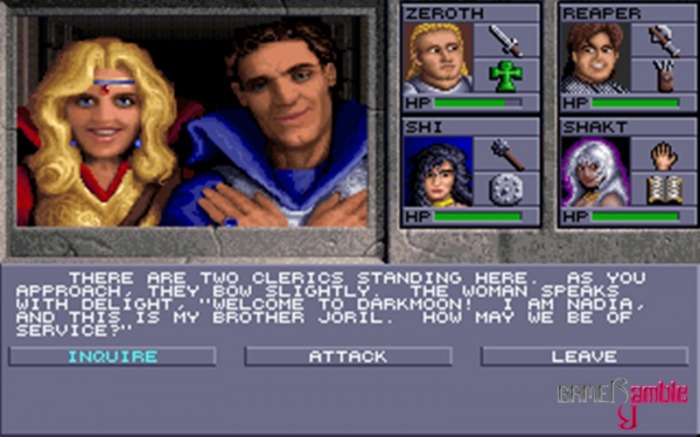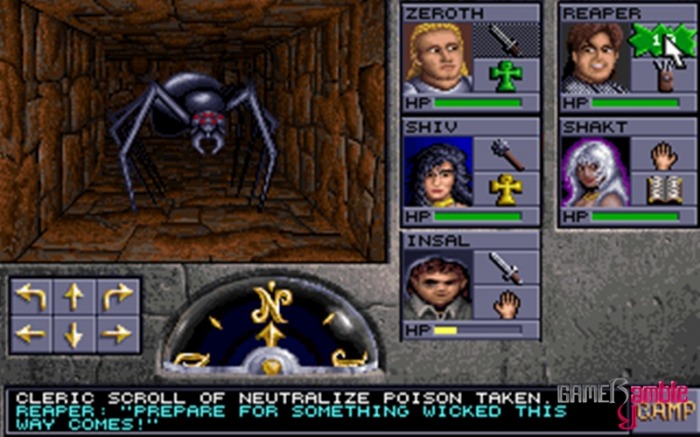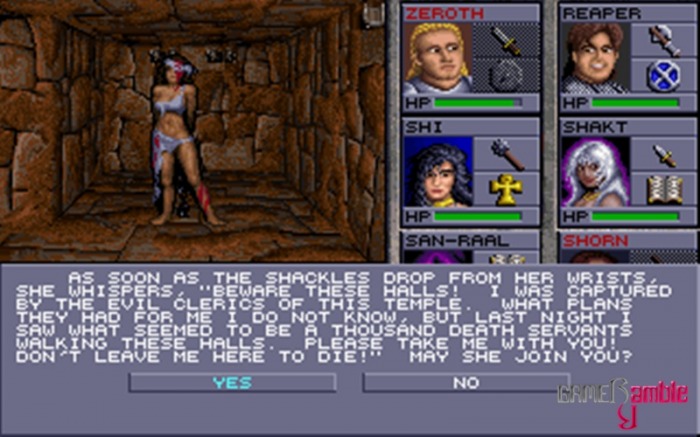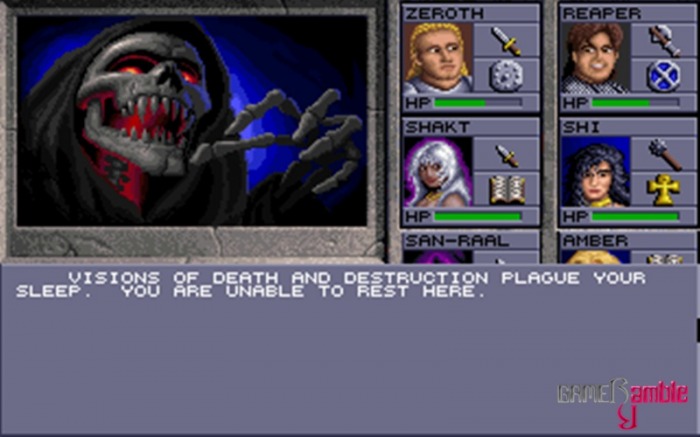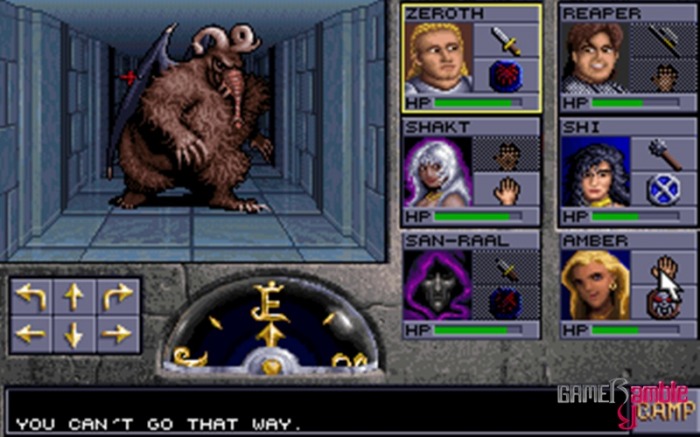Eye Of The Beholder 2: The Legend Of Darkmoon
Developer: Westwood Associates | Publisher: Strategic Simulations Inc. | Release Date: 1991 | Genre: First Person RPG | Website: n/a | Purchase: GOG
After Westwood’s first foray into the First Person RPG market was such a success, it should come as no surprise that they are back with a sequel to Eye Of The Beholder. As your party of adventurers were getting ready for a quiet evening by the fire, they receive a note from Khelben Blackstaff the mage urging them to come see him. It seems that an ancient evil is stirring in the temple of Darkmoon and the scout that he sent to investigate has not returned. Giving the party only a magical coin through which he can contact them, Khelben teleports the party to the woods near Darkmoon, beginning their quest.
If you’ve played the original Eye Of The Beholder, then this game should be very familiar to you. You once again start by creating your own four member party or jumping straight in with a pregenerated party. You can also import your characters from the first game, but since I was so pissed off with the poor ending of that one I just deleted it without thinking about save games, which in retrospect wasn’t so wise! It’s a pity that there aren’t any new portraits, which coupled with the fact that the game uses the exact same engine and interface as the first one, can make it seem that you are just playing the same thing over again.
Movement is once again step based and you can only turn at 90 degree angles. The small viewing area and cramped tunnels of Darkmoon can make the game also seem very claustrophobic. Combat is once again in real-time with you franticly clicking your characters weapons to attack. Thankfully there has been some improvements, which fans of the series will appreciate. You now find a lot more people on your quest and while there still isn’t much character interaction beyond killing monsters it is a bit more involving than the first game. While you can only create four party members you can recruit two more on your travels and the new guys are quite interesting. You can’t trust them all though and some have to be resurrected first when you find their bones. It’s a pity that you don’t learn more about their stories as, for example, I ended up with a Drow mage in my party, but never learned more about his past. You can only have six members in your party so you have to drop someone when you want another person to join. The person you drop is gone for good so think carefully if it’s worthwhile.
This time round there are plenty of new monsters for you to hack away at and trust me some of them are nasty. While the whole point of the original game was to kill one Beholder, in this game you’ll find an entire level just filled with the buggers. Don’t get me started on the Mind Flayers, Medusa’s, Basilisks and Salamanders either. Let’s just say you can be thankful that this game has loads of new magical and unique items that you can find to help you out. While the game uses the same engine as the original at least the environments that you travel through has been given a bit more variety. After a brief bit outside in the woods you’ll end up in the temple, the ancient Drow catacombs underneath it and plenty of trap filled mazes in between.
Once again, it pays to have a thief in your party and carefully examining your surroundings since the entire place is filled with illusionary walls and secret passages. At one point I was stuck in a shifting maze for three hours until I noticed that my party was spun around every time while walking down a long hallway. Also by the end of this game you’ll be sick of pressure plate and level puzzles.
The music really isn’t the highlight of the game and apart from a few key scenes you’ll mostly be wandering around in complete silence. The sound effects aren’t too bad though, and walking through a maze hearing doors opening and closing around you is quite atmospheric. The control system works best with a keyboard and mouse combination and fighting monsters and casting spells isn’t too hard. Since there is still no automap feature and the walls all look very similar its way too easy to get lost in my opinion and large parts of the game is spent just stumbling about. This isn’t made easier by some levels where the monsters are constantly respawning.
While Eye Of The Beholder 2 is definitely a classic of the genre and well worth playing it does have it’s down sides and can at times be very frustrating. Thankfully, it’s very addictive and you reach a certain point where you just have to go on only because you’ve come so far already. I’m very glad that this time round the ending was actually well worth it, although I still think there are parts of this game that was made just so that people will have to rush out and buy a strategy guide. It’s a very daunting game to actually complete and probably not suited for beginners but definitely very entertaining and rewarding.
*Review originally published 1997.
System Requirements
OS: Windows: XP / Vista / 7 / 8 / 10
Processor: 1.8 GHz Processor
Memory: 512MB RAM (1 GB recommended)
Graphics: 3D graphics card compatible with DirectX 7 (compatible with DirectX 9 recommended)
Hard Drive: 2GB HDD
Mouse, Keyboard
OS: OS X 10.7.0 or later
Processor: 1.8 GHz Processor
Memory: 512MB RAM (1 GB recommended)
Graphics: 3D graphics card compatible with DirectX 7 (compatible with DirectX 9 recommended)
Hard Drive: 2GB HDD
Mouse, Keyboard
OS: Ubuntu 14.04, Mint 17
Processor: 1.8 GHz Processor
Memory: 512MB RAM (1 GB recommended)
Graphics: 3D graphics card compatible with DirectX 7 (compatible with DirectX 9 recommended)
Hard Drive: 2GB HDD
Mouse, Keyboard



